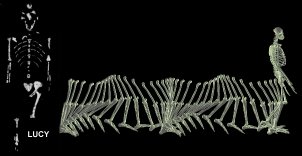
MODULE 16: Human Evolution (Origin and Diversification of Primates)
Objectives: In this module you will examine the fossil record of primates in order to get an understanding of human origins. In addition, you should gain a general understanding of the main hominid groups that characterize the fossil record of the last 4.0 million years in Africa.
Background: Origin and Diversification of Primates
The primates are a very old group and may have originated in the Late Cretaceous (> 65 mya). In relation to the other placental mammals, they are most closely related to tree shrews (Scandentia) and flying lemurs (Dermoptera) that are not far removed from the mammal group, insectivores. The "archaic primates" (e.g., Plesiadapids) and the earliest "true primates" (e.g., the adapids) are abundant in Paleocene and Eocene deposits of N. America and Europe. They are considered to have lived and evolved in tropical forest conditions.
During the Eocene there were two main groups of Primates = the Omomyids (tarsier- like) and adapids (lemur-like). By the end of the Eocene, primates had dispersed from N. America to Asia and Africa. It is becoming more clear that the dawn apes were very prevalent in China and Southeast Asia over 40 mya. The primates of Africa become central to the story of human origins by 30-25 mya. In ancient tropical forests and woodlands (in an area which now constitutes the deserts of Egypt near Cairo) many primates thrived and are especially important for their ancestral linkage to modern apes. One of the important fossil primates found in the Fayum is Aegyptopithecus, which begins to demonstrate features known in later apes:
shorter snout
advanced footbones like later apes
larger brain
heavy limb bones
powerful jaws
The origin of the Living Apes: All of the living apes, including humans, are thought to have originated from primates like Aegyptopithecus. The fossil ape Proconsul and a newly discovered fossil primate, Equatorious, from the Miocene (15 mya) of E. Africa show advanced features such as the characteristic molar pattern of later hominids, the so-called Y-5 pattern, as well as a more- reduced snout.
The origin of related great apes: Around this same time it appears that the other great apes are differentiating into recognizeable modern forms. Examples: Ramapithecus and Sivapithecus from the Miocene of Pakistan, considered to be relatives of orangutans.
There is a poor fossil record in Africa from about 10-5 mya, the interval of divergence between gorillas, chimps and the human lineage. This interval is known as the Hominid gap. In Asia primates evolve into several varieties, including Gigantopithecus, the largest primate to have ever lived. It may have been 13' in length and probably well over a thousand pounds!
The Origin of Humans

There is considerable information on the origins of humans over the last 4.0 million years. The key anatomical developments include the development of bipedalism, increasing brain size, improved capability of an opposable thumb, and development of advanced vocalization features. Many important behavioral developments occur during this time including the use of tools and development of language. These changes are seen in a sequence of fossils from Australopithecus anamensis through Homo sapiens. Read about these trends at the Talk Origins site.